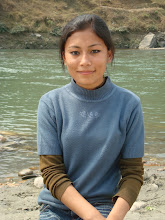"There are two types of people in this world;one who does not utilize his ability but curse God for making him a failure and the other who thanks god for giving him an ability so that he can contribute in his own way to the society." Elisha Shrestha
In above quotation,the other person reflects the personality of one of the rising literary star in the field of Nepali literature;Hari Manjushree.
In the celebration of the New Year of 2066,a book exhibition was launched in order to honor Hari Manjushree. The program was organized by The Red Cross society of Dhulikhel in which Kathmandu University's Vice Chancellor Dr Suresh Raj Sharma was the chief guest of the ceremony.
Harimanjushree's work has made a lasting impression on the literary field of Nepal by introducing simple but attractive Nepali grammatical rules. Along with this ,he has been honored by many prizes .By growing up in a poverty and ,ultimately,learning to face many challenges,Hari Manjushree has always tried to explicate a tangible picture of the society. Similarly,apart from being a writer,he is also a journalist and has worked in many media organizations. A Kavre resident,Hari Manjushree has made Kavre proud by publishing many qualitative books. In the program,many other literary figures like Mohan Duwal,etc lavishly praised Hari Manjushree for his great contribution in Nepali literature. Therefore,the chief of the ceremony Dr Suresh Raj Sharma gave certificate to Hari Manjushree and he too praised Hari Manjushree for his memorable works in literary field of Nepal.










